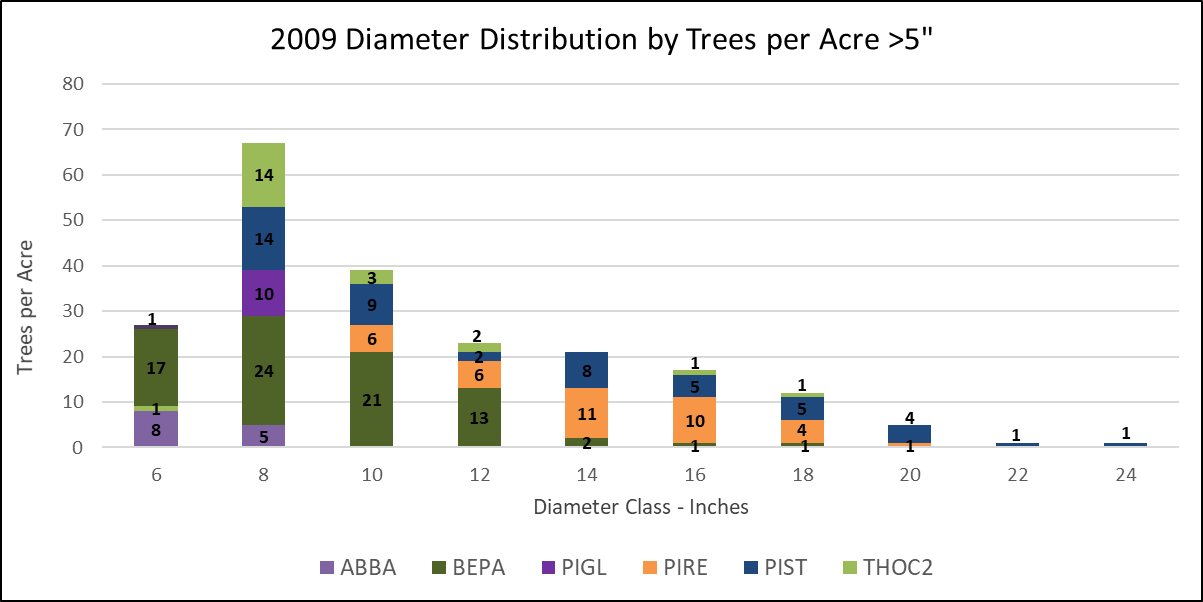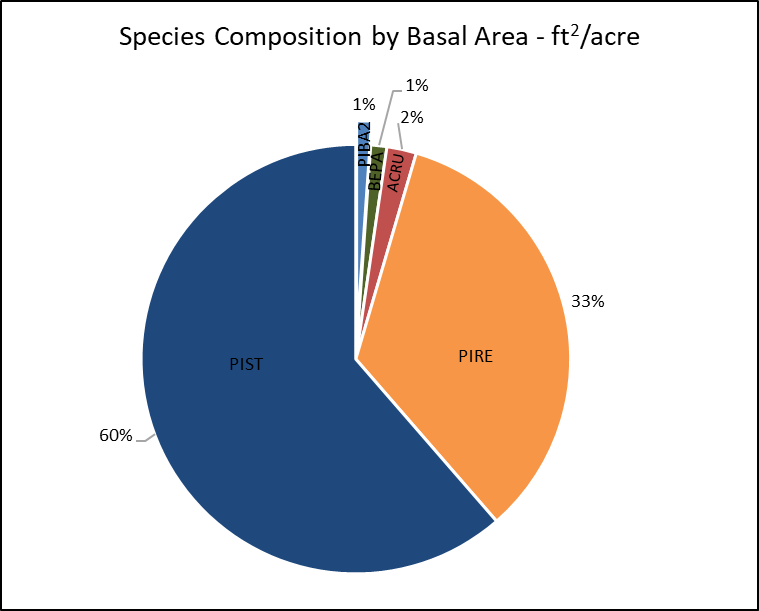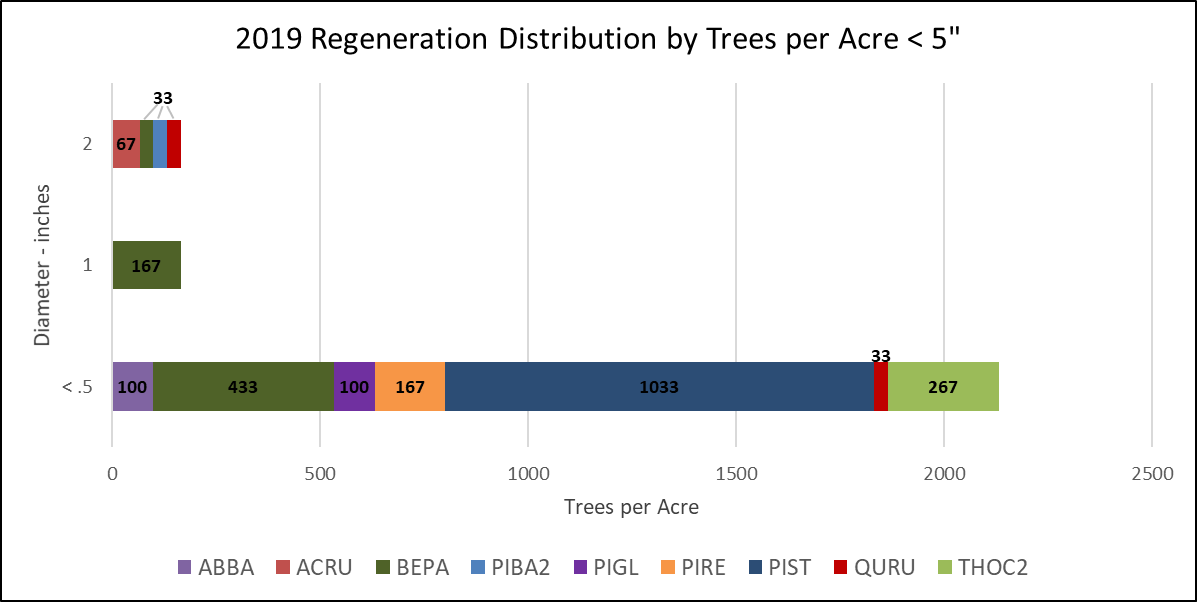Overview
This was a variable density thinning treatment in mixed pine-hardwoods that turned into a variable retention harvest with a regeneration component in gaps. Some of the gaps were planted with bur and red oak by The Nature Conservancy for an assisted migration for climate change study (Etterson et. al. 2020). The stand had variability to begin with in terms of species composition, spatial arrangement, and density. Slopes and marking prescription of trees made operations difficult, but overall ended with variable structure of thinned areas and variable gap openings. Five year follow up measurements showed a variable structure of overstory white pine and red pine with 66 ft2/ac on average. Natural regeneration of white pine, paper birch and some white cedar was by-in-large successful, creating another cohort.

Figure 1: Aerial map of Northeast (payment unit 4) 2019
Silviculture Objective(s)
Reduce stand density and increase growth and vigor. Increase the structural and spatial diversity. Increase species diversity. Old, large-dimeter mixed pine stand with structural diversity and species diversity. Break up the continuity of conifer crown fuels and crown fire potential. Maintain and enhance pine patch by mimicking the role of mixed severity fire.
Pre-treatment stand description and condition
Pre-treatment species composition:
Stand stocking varied widely from 100-200+ ft2/ac (166ft2/ac avg, 210tpa), but included white pine, red pine, paper birch, white spruce, cedar, and balsam fir. White pine and red pine made the overstory cohort with paper birch and balsam fir dominating the smaller size classes. The understory was heavy balsam fir and beaked hazel.
Pre-treatment growth and stocking:
See figures below: ABBA=Balsam fir; BEPA=Paper birch; PIGL=White spruce; PIRE=Red pine; PIST=White pine; THOC2=Northern white cedar.
Pre-treatment forest health issues:
There was some red pine advanced regen occurring but was infected by shoot blight from overstory tees. The understory/midstory had 1,450 tpa of balsam fir on average.
Landowner objectives/situation:
Maintain and enhance pine patch, the pine cover type, and structural/vegetative diversity of the site. Fuels objectives were to reduce canopy and ladder fuels for crown fire initiation.

Figure 2: 2020 FSA satellite image showing harvest area (source: Google maps)
Silviculture Prescription
To achieve the variable density condition, harvest merchantable hardwoods, jack pine, spruce, and fir. Thin red pine to a residual density of 80-90 ft2/ac. Do not harvest white pine. Summer harvest preferred to encourage natural regen. Crush live standing balsam fir and create 25’ slash free zone around unit. Under burn after harvest. Legacy patch not required.
What actually happened during the treatment
The treatment was not a textbook variable thinning treatment, but a more variable retention harvest. Instead of gaps-thin-skips, the result was more variable sized openings with variable spacing, thinned matrix. This was due to the species spatial arrangement. Marking was by species designation to harvest all hardwoods, jack pine, spruce and fir, while leave tree marking to thin the red pine. This led to larger gap openings than initially envisioned (1/2ac to 3ac gap sizes) and somewhat less residual overstory density than anticipated.

Figure 3: Thinned area of the stand
Natural regeneration was prescribed but not the focus of the treatment. Site prep burning was dropped due logistics and operational constraints, but some soil disturbance occurred through conventional harvest equipment operations during the mild winter of 2011/12. Intermittent slopes and leave tree arrangement slowed operations.
This site was chosen as a study location for a climate change assisted migration study focusing on bur and red oak of varying seed zones within the gaps, planted by TNC in 2013. This site has been maintained since with mechanical tree release and browse protection.
Post-treatment assessment
The seven-year post-harvest monitoring showed a variable overstory density of 66 ft2/ac on average, with variable gaps 0.5 to 3 ac in size. White pine was shifted to the primary overstory species, ranging from 8-24 inches. Balsam fir was significantly reduced in the understory though operations and crushing. The objectives to maintain a structurally and vegetative diverse stand condition was met as well as lowering the potential for crown fire initiation.
At the stand level, 2019 regeneration was largely successful with 1,033 tpa white pine and 633 tpa of paper birch (see figures). This was especially surprising considering winter harvest with no site prep; although the winter of 2011-2012 was mild in terms of temperature and snow depth. Northern white cedar was regenerating in the northern portion of the stand. There is red pine regeneration, though expected to die due to shoot blights. Competition from shrubs and raspberry was significant in the gaps but was reduced under partial canopy. Strangely absent for this area was aspen regeneration, though very few mature aspen were in the pre-treatment condition. (Note. One monitoring plot fell near a TNC plot with planted northern red oak seen in the stocking survey. Plots were 1/300th acre, thus had a large confidence interval and did vary widely).
See figures below: ABBA=Balsam fir; BEPA=Paper birch; PIGL=White spruce; PIRE=Red pine; PIST=White pine; THOC2=Northern white cedar; QURU=Red Oak.

Figure 4: Gap area of the stand, planted and tree released by TNC
Plans for future treatments
There are no plans for future treatment at this time. The exception would be plot maintenance with the TNC study plots. As a silvicultural system, one option may be to perform another entry at year 20 to initiate another age class in gaps to manage the stand as multi-aged.
Costs and economic considerations
Species by designation and size, while cut-tree marking the red pine reduced layout costs. Cut tree marking all species would have made the treatment result closer to a true variable density thin, but incurred more time in the marking prescription interpretation, and more in paint and labor.
Other notes
References: Etterson, J. R., M. W. Cornett, M. A. White, and L. C. Kavajecz. 2020. Assisted migration across fixed seed zones detects adaptation lags in two major North American tree species. Ecological Applications 00(00):e02092. 10.1002/eap.2092
Climate Adaptation Considerations
Early results from Etterson et. al. (2020) showed that red oak and bur oak seedlings sourced from the local seed zone (104) and one seed zone south (105) had high survival (> 90%) across northeastern Minnesota on a variety of sites. In aggregate, oaks sourced from southern seed zone showed overall higher growth and survival than those from the local seed zone. Oak seedling growth and survival at Anderson Lake site fit the overall pattern across the study area. Results indicate that climate shifts over the last century have created more favorable conditions for these oak species, making them competitive in these environments. These oak species can be considered viable on a wide variety of sites in this region and can increase the diversity and adaptive capacity of northeastern Minnesota upland forests.

Figure 5: Bur oak seedling

Figure 6: Red oak seedling
Summary / lessons learned / additional thoughts
Ultimately the treatment was a success in achieving the desired objectives for a structurally diverse stand. Stand density was lower than expected with the size of the gaps, but this was attributed to the marking designation and species spatial arrangement. Though it was a winter harvest, the mild winter provided conditions conducive to natural regeneration, but tree release from brush competition is still needed within gaps or openings. There was little to no aspen on this site before, which may have further benefited the natural pine and birch regeneration through the absense of major aspen competition. The site was not underburned after the harvest as planned. Incorporating harvest boundaries down to natural fire breaks and less stand edge to area ratio, would have aided in the ability to conduct a site prep burn. To date, there are relatively few of these treatments on the Superior National Forest that promote stand complexity in pine stands quite like this. This treatment serves as a point of reference to guide future treatments of this type as well as crafting straightforward marking guides that can achieve similar objectives.

Figure 7: Other stand perspective
Supplemental content

Pre-treatment species composition by BA.

Pre-treatment diameter distribution.

Post-treatment species composition by BA.

Post-treatment diameter distribution.

Post-treatment regeneration distribution.
